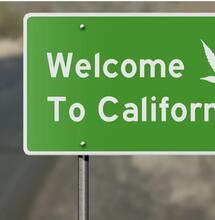California still has a big problem with illegal weed.

November 8th, 2021, is the fifth anniversary of California passing proposition 64 and legalising recreational cannabis. The State is currently one of the leading global cannabis markets, generating billions of dollars.
The fact is, however, that legal weed makes up only a fraction of The Golden State's cannabis market. Most cannabis sales, as much as 80-90%, are still coming from illicit and unregulated businesses—something which, if nothing else, is a significant threat to public health.
California is home to some of the strictest rules and regulations in the legal US cannabis industry. This has resulted in industry operators leaving the State or continuing operations in the illegal market.
The unlawful market in California is on course to make around $8 billion in annual sales, more than twice what legal sales are bringing in.
Preventing California from having a safe and productive legal market includes local government oppositions, high taxation, unlicensed businesses.
Going "legal" has often meant forfeiting a large portion of the profit. Businesses regularly pay a tax rate of 70%, partly because they are breaking federal law and are unable to take tax deductions. Politicians view the industry as a great source of tax revenue and so set the rates higher. This high level of taxation has destroyed the legal dream in California, pricing cannabis out of the market for all.
These issues create a significant gap between California's legal market and the thriving illegal selling of unregulated products. Many of which contain dangerous ingredients that could lead to a health emergency like the vape crisis of 2019.
Many people reported respiratory illnesses caused almost entirely by illegal cannabis vapes, made with harsh chemicals in the cheapest way possible. People in Los Angeles were buying vape pens that they didn't know were illegal or that they were shopping at unlawful dispensaries.
Proof of the prevalence of the illegal market is easily seen when looking at the amount of legal dispensaries trading in California. The state has around two legal cannabis customer-facing retail spaces per 100,000 people. In comparison, Oregon, Colorado and Washington all hold a ratio of approximately 17.9 retail spaces per 100,000 people.
In February 2020, a market analysis report found that California had only 823 licensed physical cannabis stores but as many as 3,000 unregulated, illegal retail and delivery services.
Consumers need to be hyper-vigilant to differentiate between a legal and illicit cannabis business, especially with delivery services. Delivery services have an easier time hiding their legal status, meaning that you could quickly be ordering from a drug dealer and have absolutely no idea!
The illicit market is not only damaging the regulated industry but also the environment.
There are an estimated 50,000 illegal cultivation farms and grow-ops in California, many of which use prohibited pesticides entering natural waterways and harming wildlife. Additionally, the criminal element to these sites, often run by heavily armed gangs and cartels, stretches to stealing millions of gallons of water from neighbouring farms and communities.
One of the biggest promises of California's legal market was that it would serve as a form of atonement. It would produce "generational wealth" for BAME communities who suffered disproportionately from prohibition.
As it stands, however, many more Black and brown traders in California have lost money through legal cannabis businesses rather than made a healthy profit. Even with help from the "social equity" programs designed to help them.
Even the differences between federal and state regulations play a part in aiding the illicit cannabis market. The inconsistency between individual state law and federal law is causing colossal obstacles in the cannabis industry. In terms of running a legal business, it isn't easy to get a bank account, which means trading solely with cash. And that can be very dangerous.
"You don't have a real cannabis industry if the dominant portion of it has no interest in being legal," "There's no other regulated industry in the world that I know of that operates like that," Adam Spiker- executive director of the cannabis trade association, the Southern California Coalition.
Legalisation remains trapped in a limbo of highly complex, low priority issues that are unlikely to be resolved in the near future. It's great that you can purchase cannabis products with consistent, traceable dosage levels at hundreds of legal dispensaries across California. It is also an achievement that arrests for cannabis crimes have reduced significantly. However, if legalisation was intended to transform California's weed market into a well organised, legal, and profitable industry, these first five years would be deemed unsuccessful.









